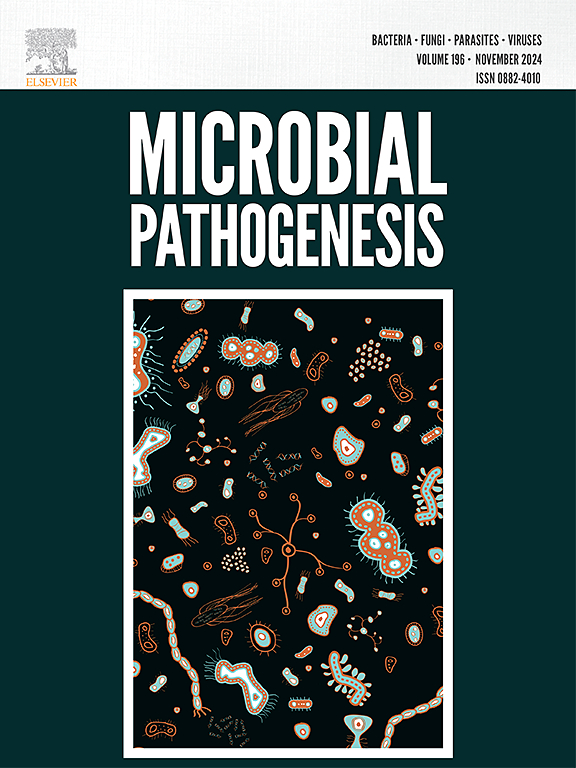Computational Screening and Cytotoxic Analysis of Beta vulgaris L. phytoconstituents as potent Dengue virus-NS5 Polymerase inhibitors
IF 3.5
3区 医学
Q3 IMMUNOLOGY
引用次数: 0
Abstract
Dengue infection is one of the most widely spread flavivirus infections. Despite the fatality it could cause, no antiviral treatment is currently available to treat the disease and its associated pathophysiological conditions. This study aimed to search drug-like compounds for possible inhibitors of the NS5 protein of dengue virus (serotype 2). In the present study, a data set of twenty-five Beta vulgaris. L-based phytoconstituents was developed. We employed machine learning (ML) data pre-processing, screening of differentially expressed transcripts and genes, identification of common transcriptional signatures and pathways and function enrichment analysis of dengue infection; and protein-protein interaction network construction and identification of hub genes. ML data revealed that NS5 mRNA was downregulated by betanin, kaempferol, quercetin hydrate, and isovitexin-2-O-xyloside. Moreover, administering these compounds can alleviate host innate immune factor suppression mediated by NS5, thereby exhibiting antiviral activity. Molecular docking and pharmacokinetics studies revealed a potential therapeutic role of betanin, kaempferol, quercetin hydrate, and isovitexin-2-O-xyloside phytoconstituents as potent antiviral phytocompounds. MD simulation and post-simulation analysis, including principal component analysis and dynamic cross-correlation, confirmed the antiviral therapeutic potency of betanin, kaempferol, and isovitexin-2-O-xyloside against dengue virus infection. In vitro cytotoxic studies also depicted nontoxic effects of betanin and quercetin hydrate in Vero and CHO cells at a concentration range of 20–0.31 μM. In summary, computational screening and in vitro cytotoxicity analysis revealed that betanin, kaempferol, and isovitexin-2-O-xyloside may prove as potential drug candidates against dengue virus regarding their possible safety and antiviral activity in future.

登革病毒- ns5聚合酶抑制剂植物成分筛选及细胞毒性分析。
登革热感染是传播最广泛的黄病毒感染之一。尽管它可能导致死亡,但目前还没有抗病毒治疗方法可以治疗这种疾病及其相关的病理生理状况。本研究旨在寻找可能抑制登革热病毒(血清型2)NS5蛋白的药物样化合物。在本研究中,一个数据集25个贝塔寻常。开发了l基植物成分。我们采用机器学习(ML)数据预处理,筛选差异表达的转录物和基因,鉴定常见的转录特征和途径,并对登革热感染进行功能富集分析;以及蛋白-蛋白相互作用网络的构建和枢纽基因的鉴定。ML数据显示,甜菜素、山奈酚、水合槲皮素和异牡荆素-2- o -木糖苷下调NS5 mRNA表达。此外,给药这些化合物可以减轻NS5介导的宿主先天免疫因子抑制,从而表现出抗病毒活性。分子对接和药代动力学研究揭示了甜菜素、山奈酚、水合槲皮素和异牡荆素-2- o -木糖苷等植物成分作为有效的抗病毒植物化合物的潜在治疗作用。MD模拟和模拟后分析,包括主成分分析和动态相互关联,证实了甜菜素、山奈酚和异牡荆素-2- o -木糖苷对登革热病毒感染的抗病毒治疗作用。体外细胞毒性研究也描述了甜菜素和水合槲皮素在20-0.31 μM浓度范围内对Vero和CHO细胞的无毒作用。因此,基于硅基和细胞毒性分析的筛选试验表明,甜菜素、山奈酚和异牡荆素-2- o -木糖苷在未来的安全性和抗病毒活性方面可能被证明是抗登革热病毒的潜在候选药物。
本文章由计算机程序翻译,如有差异,请以英文原文为准。
求助全文
约1分钟内获得全文
求助全文
来源期刊

Microbial pathogenesis
医学-免疫学
CiteScore
7.40
自引率
2.60%
发文量
472
审稿时长
56 days
期刊介绍:
Microbial Pathogenesis publishes original contributions and reviews about the molecular and cellular mechanisms of infectious diseases. It covers microbiology, host-pathogen interaction and immunology related to infectious agents, including bacteria, fungi, viruses and protozoa. It also accepts papers in the field of clinical microbiology, with the exception of case reports.
Research Areas Include:
-Pathogenesis
-Virulence factors
-Host susceptibility or resistance
-Immune mechanisms
-Identification, cloning and sequencing of relevant genes
-Genetic studies
-Viruses, prokaryotic organisms and protozoa
-Microbiota
-Systems biology related to infectious diseases
-Targets for vaccine design (pre-clinical studies)
 求助内容:
求助内容: 应助结果提醒方式:
应助结果提醒方式:


